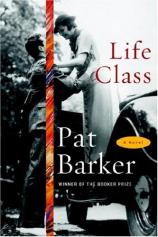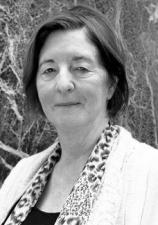Life Class
Review
Life Class
LIFE CLASS begins with a glimpse over the shoulder of Paul Tarrant, a student at the famous London art school, the Slade. He is struggling to draw a nude model (you know it’s nearly 100 years ago because the women and men have separate sessions), awash in feelings familiar to anybody who attempts art: self-doubt, frustration and a looming fear of professorial comments that nail a wrongness of proportion or clumsiness of line.
The professor in this instance is Henry Tonks, who was a real person --- a doctor-turned-artist who, in the wake of World War I, worked with a plastic surgeon to document the repair of soldiers’ mutilated faces. Here again is The Great War, the scene of Pat Barker’s deservedly famous Regeneration trilogy (one of the volumes won the Man Booker Prize), and here too is her penchant for mixing actual and invented individuals. Other recognizable characters include the extravagant society hostess Lady Ottoline Morrell and the artist Augustus John. But in LIFE CLASS she focuses on the nexus between war and art, and brings an artist’s eye to her descriptions of a midnight picnic (“In the moonlight…the poppies looked black and the corn was silver”) or the devastation at the Belgian front, where “the land on either side of the road is ruined --- pockmarked, blighted, craters filled with foul water, splintered trees, hedges and fields gouged out….”
Barker hadn’t planned to go back to World War I, she told the (British) Sunday Times, but she was stirred by the artists of that period (if you saw the film Carrington, you may remember Mark Gertler, Dora Carrington’s stormy suitor before she settled on Lytton Strachey as the love of her life). There may have been a proper gender division in life-drawing classes, but outside the studio these iconoclastic circles were known for sexual as well as aesthetic rebellion, and the first part of LIFE CLASS --- while the war is still looming --- is very much occupied with love triangles. Paul has a brief, torrid affair with Teresa Halliday, an artist’s model, and is stalked by her abusive husband. He is more profoundly drawn, however, to a fellow student named Elinor Brooke, who apparently wishes to be no more than friends with him or his chief rival, Kit Neville, a privileged chap whose canvases, ironically, focus on scenes of urban industrial life that are straight out of Paul’s working-class background.
Ah, yes --- class. It stretches through the book like a high-tension wire. Paul’s grandmother, an East End slumlord, left him enough money to go to the Slade; becoming an artist is, for him, a way of getting out of “the shadow of the ironworks that gobbled men up at the start of a shift and regurgitated them twelve hours later fit for nothing but booze and sleep.” In seeing Teresa he is returning to his “common” origins; with Elinor and Neville he is transgressing them. Entering the Café Royal, a student hangout that isn’t exactly Starbucks, he comments on how “sleek and glossy” the patrons are “compared to the creatures who lived in the streets around his lodgings, scurrying about in their soot-laden drizzle, the women so tightly wrapped they seemed to be bundles of clothes walking. This was another England, and passing between the two, he was aware of a moment’s dislocation, not unlike vertigo.” Paul is a man straddling two worlds, and through him Barker seems to suggest that social hierarchies were being blasted away --- both by the self-conscious bohemianism of the artistic subculture and the leveling impact of the battlefield.
The war is a way for LIFE CLASS to wrestle with questions about the purpose of art (given massive death and destruction, what are mere pictures good for?), echoing Paul’s memory of his skeptical Gran: “Art! It’s not for people like us….” Each character reacts differently to the prospect of battle. Paul, turned down for active service because of a weak chest, goes to the front lines as a medical orderly and ambulance driver, and his painting, forged in a world of death, finally starts to come alive. Even Professor Tonks approves. From the start Neville sees war as a proper subject for art and makes a career of it, so much so that when the fighting ends he predicts his work will no longer draw attention (“Nobody wants to look at a nightmare once they’ve woken up”).
Elinor is more complicated. Although a gifted artist who, thanks to her gender, is able to continue to work while her male admirers are at the front, I don’t get a strong sense of her inner life. Her proto-feminist resistance to marriage (“No man was ever going to entice her into a cage….”) seems a bit of an assumed role (she bobs her hair, but still wears stays). And her determination to ignore the war as much as possible, while admirably honest (“Of course…it matters that people are dying,” she says. “I just don’t think that’s what art should be about. It’s like painting a train crash”), makes her a cool, rather distant character.
The crux of the book, it seems to me, is the way war divorces people from their former lives, which Barker communicates through a series of letters between Elinor and Paul (which, by the way, are so beautifully written that one wonders why they didn’t become novelists rather than artists). He begins by wanting to think of her carrying on a more-or-less normal life back home, but as the violence mounts, he realizes that he now inhabits an entirely different world and has been inalterably changed by the experience. She cannot share it, even though their relationship is physically consummated when she visits Paul at the front.
The real intimacy in LIFE CLASS (though not in a sexual sense) is between Paul and Richard Lewis, the Quaker volunteer who shares his tent. This subtly drawn friendship is the most touching of the entire book, and the purest --- worshipful but chaste on Lewis’s side, ruefully affectionate on Paul’s. Elinor and Paul, on the other hand, seem permanently trapped in bleak ambiguity. With the war a chasm between them, love is no longer enough. Wounded and on leave in London, Paul thinks longingly of the front: “The sooner he was out there again the better.… He didn’t belong here.” The divide between peacetime life and the kill-or-be-killed starkness of battle --- between those who have lived and painted in safety and those who have risked (and witnessed) everything --- is as horrifyingly relevant today as it was then. I’m afraid it will be with us as long as there is war.
Reviewed by Kathy Weissman on December 30, 2010
Life Class
- Publication Date: January 29, 2008
- Genres: Fiction
- Hardcover: 320 pages
- Publisher: Doubleday
- ISBN-10: 0385524358
- ISBN-13: 9780385524353










